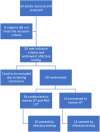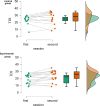Palmitoylethanolamide and Luteolin for Postinfectious Olfactory Disorders: How Clinically Meaningful Is Its Effect?
- PMID: 38861957
- PMCID: PMC11651318
- DOI: 10.1159/000539651
Palmitoylethanolamide and Luteolin for Postinfectious Olfactory Disorders: How Clinically Meaningful Is Its Effect?
Abstract
Introduction: The prevalence of post-viral olfactory dysfunction has increased significantly during the COVID-19 pandemic, posing a major challenge for patients and practitioners. While olfactory training (OT) is a common approach to therapy, there has been increasing interest in supplementing therapy with a combination of palmitoylethanolamide (PEA) and luteolin (LUT), which are known for their anti-inflammatory properties. In this study, their efficacy in the treatment of patients with olfactory loss following upper respiratory tract infections, mainly COVID-19, was investigated in an outpatient clinic.
Methods: Fifty patients with persistent olfactory dysfunction were randomized to two groups: one receiving OT and PEA-LUT, the other OT alone. Olfactory function was evaluated before and after treatment.
Results: The study group showed significant improvements in odor discrimination and overall olfactory function (TDI score) after treatment with PEA-LUT and OT, while the control group did not. However, when clinically meaningful improvements were considered, there was no significant difference between the groups.
Conclusion: The present study suggests that while PEA-LUT may have the potential to improve olfactory function in post-viral dysfunction, the additional benefit over OT alone may be limited. These results contrast with some previous studies.
Keywords: Olfactory loss; Palmitoylethanolamide and luteolin; Upper respiratory tract infection patients.
© 2024 The Author(s). Published by S. Karger AG, Basel.
Conflict of interest statement
The authors have no conflicts of interest to declare.
Figures


Similar articles
-
Prescription of Controlled Substances: Benefits and Risks.2025 Jul 6. In: StatPearls [Internet]. Treasure Island (FL): StatPearls Publishing; 2025 Jan–. 2025 Jul 6. In: StatPearls [Internet]. Treasure Island (FL): StatPearls Publishing; 2025 Jan–. PMID: 30726003 Free Books & Documents.
-
The Black Book of Psychotropic Dosing and Monitoring.Psychopharmacol Bull. 2024 Jul 8;54(3):8-59. Psychopharmacol Bull. 2024. PMID: 38993656 Free PMC article. Review.
-
Signs and symptoms to determine if a patient presenting in primary care or hospital outpatient settings has COVID-19.Cochrane Database Syst Rev. 2022 May 20;5(5):CD013665. doi: 10.1002/14651858.CD013665.pub3. Cochrane Database Syst Rev. 2022. PMID: 35593186 Free PMC article.
-
Interventions for the treatment of persistent post-COVID-19 olfactory dysfunction.Cochrane Database Syst Rev. 2022 Sep 5;9(9):CD013876. doi: 10.1002/14651858.CD013876.pub3. Cochrane Database Syst Rev. 2022. PMID: 36062970 Free PMC article.
-
Physical interventions to interrupt or reduce the spread of respiratory viruses.Cochrane Database Syst Rev. 2023 Jan 30;1(1):CD006207. doi: 10.1002/14651858.CD006207.pub6. Cochrane Database Syst Rev. 2023. PMID: 36715243 Free PMC article.
References
-
- Whitcroft KL, Hummel T. Olfactory dysfunction in COVID-19: diagnosis and management. JAMA. 2020;323(24):2512–4. - PubMed
-
- D’Ascanio L, Vitelli F, Cingolani C, Maranzano M, Brenner MJ, Di Stadio A. Randomized clinical trial “olfactory dysfunction after COVID-19: olfactory rehabilitation therapy vs. intervention treatment with Palmitoylethanolamide and Luteolin”: preliminary results. Eur Rev Med Pharmacol Sci. 2021;25(11):4156–62. - PubMed
Publication types
MeSH terms
Substances
LinkOut - more resources
Full Text Sources
Medical

